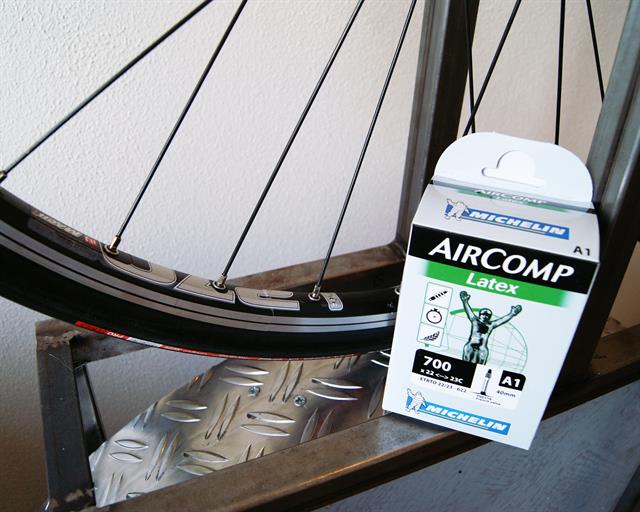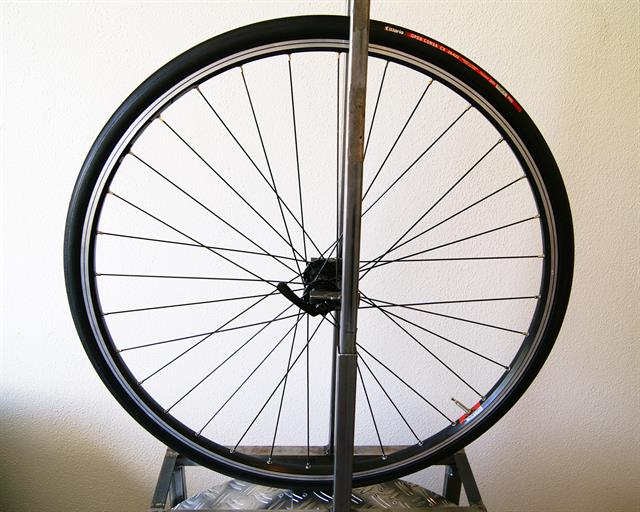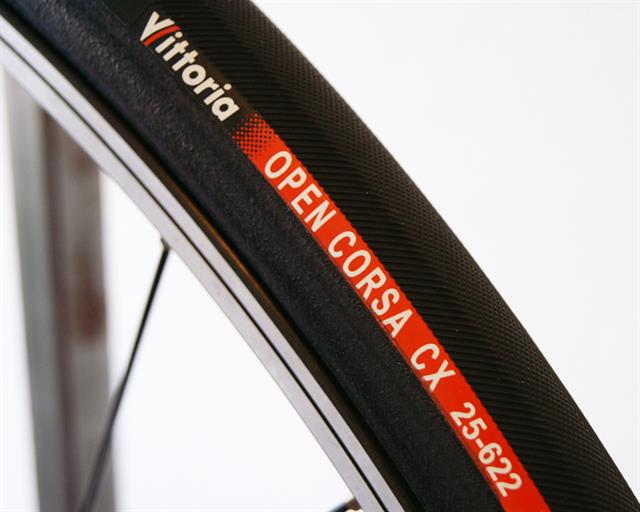Tire Lab Test: Vittoria Open Corsa CX III Latex Tube 25
Contents and Test Summary
- Introduction
- Manufacturer Specifications
- Size, Weight, Thickness
- Rolling Resistance: 13.0 Watts
- Puncture Resistance: No Data
- Static Wet Grip: No Data
- Conclusion: 4.0 / 5 Recommended
- Comments

This is part two of a latex vs butyl road bike inner tube comparison. I'm going to use last week's review of the Continental Grand Prix 4000S II with a latex tube Read Here as a template and won't add much to this review except the data. This time I'm using the Vittoria Open Corsa CX III reviewed Here. Just like last weeks review I've substituted the standard 100 grams Continental butyl inner tube for a 80 grams Michelin AirComp A1 Latex tube. I've chosen the GP4000S II and Open Corsa CX III to test a latex inner tube simply because these are the fastest road bike tires I had the chance to test up to now.
If you're purely interested in the differences between butyl and latex tubes, I highly recommend you to also read this special article which includes latex,butyl and light butyl tubes.
Inner Tubes Specifications
Butyl Inner Tube
- Brand: Continental
- Model: Race 28, 18-25 x 622
- Weight: 100 grams
Latex Inner Tube
- Brand: Michelin
- Model: AirComp A1 Latex
- Weight: 80 grams
Manufacturer Specifications
| Manufacturer Specifications | |
|---|---|
| Brand | Vittoria |
| Model | Open Corsa CX III Latex Tube |
| Year | 2014 |
| Tire Type | Tubetype (clincher) |
| Supplied By | Bought in store |
| New or Used | New |
| Mileage | 0 km |
| Price Range | High |
| Buy At | |
| Manufacturer part number | 111.391.SC.111.BX |
| TPI | 320 |
| Compound | ISOgrip Compound |
| Bead | Folding |
| ETRTO | 25-622 |
| Size Inch | 28" |
| Specified Width (mm) | 25 |
| Specified Weight | 220 grams |
| Max Air Pressure (psi) | 145 |
| Made In | Pro Data |
| Available Sizes |
23-622 (700x23C) 25-622 (700x25C) |
Vittoria Open Corsa CX III Latex Tube 25 Test Results

Size, Weight, and Thickness Measurements
| Size, Weight and Thickness Measurements | |
|---|---|
| Specified Weight | 220 grams |
| Measured Weight | 237 grams |
| System Adjusted Weight (tire + inner tube (100 gr) |
337 grams |
| Measured Width | 28 mm (un-round) |
| Measured Height | Pro Data |
| Tire Circumference | Pro Data |
| Total Tire Thickness Center | No Data |
| Total Tire Thickness Sidewall | Pro Data |
| Unmounted Casing Width | No Data |
| Unmounted Tread Width | No Data |
| Tread Cover (Tread / Casing Ratio) | No Data |
| All size measurements are taken at an air pressure of 100 psi / 6.9 bars on a 17.8 mm inner width rim. | |
No differences, same as butyl inner tube.
Rolling Resistance Test Results
| Rolling Resistance Test Results | |
|---|---|
| Inner Tube | Michelin Latex |
| Measured Width | 28 mm (un-round) |
| Rolling Resistance Real tire width in mm: 22-24 = 132 psi/9.1 bar 25-27 = 120 psi/8.3 bar 28-30 = 108 psi/7.4 bar 31-32 = 100 psi/6.9 barUltra High Air Pressure (108 psi / 7.4 bar) |
Pro Data |
| Rolling Resistance Real tire width in mm: 22-24 = 110 psi/7.6bar 25-27 = 100 psi/6.9 bar 28-30 = 90 psi/6.2 bar 31-32 = 83 psi/5.7 barExtra High Air Pressure (90 psi / 6.2 bar) |
Pro Data |
| Rolling Resistance Real tire width in mm: 22-24 = 88 psi/6.1 bar 25-27 = 80 psi/5.5 bar 28-30 = 72 psi/5.0 bar 31-32 = 67 psi/4.6 barHigh Air Pressure (72 psi /5.0 bar) |
13.0 Watts CRR: 0.00390 |
| Rolling Resistance Real tire width in mm: 22-24 = 66 psi/4.6 bar 25-27 = 54 psi/4.1 bar 28-30 = 60 psi/3.7 bar 31-32 = 50 psi/3.4 barMedium Air Pressure (54 psi / 3.7 bar) |
Pro Data |
| The Road Bike section is a multi tire size section, air pressures have been adjusted to the measured casing width. All numbers are for a single tire at a speed of 29 km/h / 18 mph and a load of 42.5 kg / 94 lbs. Use the formula: RR (Watts) = CRR * speed (m/s) * load (N) to calculate rolling resistance at a given speed and load. |
|
The latex tube definitely has less rolling resistance when compared to the butyl tube, although the difference isn't as big as seen with mountain bike tires Read my special MTB article. Tests are run at 18 mph / 29 km/h, which might be a little low for road bikes.
- At 120 psi / 8.3 bar, the latex inner tube has 1.3 watts less rolling resistance.
- At 120 psi / 8.3 bar, Coefficient of rolling resistance (CRR) is 0.00039 lower
- At 100 psi / 6.9 bar, the latex inner tube has 1.4 watts less rolling resistance.
- At 100 psi / 6.9 bar, Coefficient of rolling resistance (CRR) is 0.0042 lower
- At 80 psi / 5.5 bar, the latex inner tube has 1.8 watts less rolling resistance.
- At 80 psi / 5.5 bar, Coefficient of rolling resistance (CRR) is 0.00054 lower
- At 60 psi / 4.1 bar, the latex inner tube has 2.3 watts less rolling resistance.
- At 60 psi / 4.1 bar, Coefficient of rolling resistance (CRR) is 0.00069 lower
Puncture Resistance Test Results

| Puncture Resistance Test Results (higher is better) | |
|---|---|
| Total Puncture Score Tread | No Data |
| Total Puncture Score Sidewall | Pro Data |
| Tread Puncture Force Sharp Needle | 12 Points |
| Tread Puncture Force Blunt Needle | No Data |
| Tread Total Tire Thickness | No Data |
| Sidewall Puncture Force Sharp Needle | Pro Data |
| Sidewall Puncture Force Blunt Needle | No Data |
| Sidewall Total Tire Thickness | Pro Data |
No differences, same as butyl inner tube.
Static Grip Test Results
NOTE: Grip test data is only available on tires tested after November 2018. You can find more information about our grip test here: Introducing Grip Testing
| Static Grip Test Results | |
|---|---|
| Wet Grip Average | No Data |
| Wet Grip Center | No Data |
| Wet Grip Edge | No Data |
| Grip in points = coefficient of friction * 100 Road bike grip test rim width = 19.0 mm |
|
Conclusion
This is just added to the database as a reference, I've added an updated conclusion to the GP4000S II with latex tube review Read Here
RATING:
4.0
/ 5
TEST VERDICT:
Recommended
